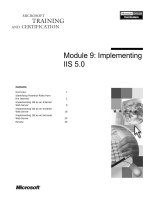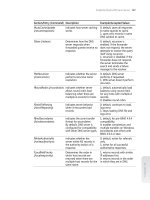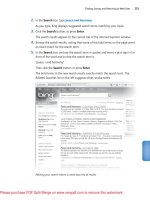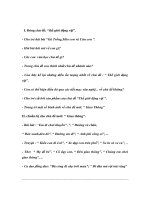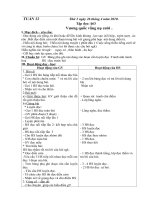Tài liệu Windows Presentation Foundation 4.5 Cookbook docx
Bạn đang xem bản rút gọn của tài liệu. Xem và tải ngay bản đầy đủ của tài liệu tại đây (7.07 MB, 464 trang )
Windows Presentation
Foundation 4.5
Cookbook
Over 80 recipes to effectively and efciently
develop rich Windows client applications on
the Windows platform
Pavel Yosifovich
BIRMINGHAM - MUMBAI
Windows Presentation Foundation 4.5
Cookbook
Copyright © 2012 Packt Publishing
All rights reserved. No part of this book may be reproduced, stored in a retrieval system, or
transmitted in any form or by any means, without the prior written permission of the publisher,
except in the case of brief quotations embedded in critical articles or reviews.
Every effort has been made in the preparation of this book to ensure the accuracy of the
information presented. However, the information contained in this book is sold without
warranty, either express or implied. Neither the author, nor Packt Publishing, and its dealers
and distributors will be held liable for any damages caused or alleged to be caused directly or
indirectly by this book.
Packt Publishing has endeavored to provide trademark information about all of the companies
and products mentioned in this book by the appropriate use of capitals. However, Packt
Publishing cannot guarantee the accuracy of this information.
First published: September 2012
Production Reference: 1150912
Published by Packt Publishing Ltd.
Livery Place
35 Livery Street
Birmingham B3 2PB, UK.
ISBN 978-1-84968-622-8
www.packtpub.com
Cover Image by Mark Holland ()
Credits
Author
Pavel Yosifovich
Reviewers
Alon Fliess
Ariel Ben Horesh
Stas Shteinbook
Dan Vestergaard
Acquisition Editor
Rukshana Khambatta
Lead Technical Editor
Kedar Bhat
Technical Editor
Madhuri Das
Project Coordinator
Yashodhan Dere
Proofreaders
Aaron Nash
Maria Gould
Indexer
Rekha Nair
Graphics
Aditi Gajjar
Production Coordinator
Shantanu Zagade
Cover Work
Shantanu Zagade
About the Author
Pavel Yosifovich is the CTO of CodeValue (), a software
development, consulting, and training company, based in Israel. He writes, consults, and
trains developers on various software development topics, from Windows internals, to .NET
enterprise systems, and almost everything in between. He’s a Microsoft MVP and a frequent
speaker at national events, such as Tech-Ed and DevAcademy.
In the past, he co-founded the startup company Quiksee that was acquired by Google in
September 2010.
Writing a book is a tremendous effort, even if you know what you want to
write (and I didn’t some of the time). It wasn’t possible without the support
of my family: my wife Idit, and my kids, Daniel and Amit, and the latest
recruit, Yoav. Thank you for the making the time and more than that – thank
you for the support and encouragement along the way. It’s certainly easy to
give up, but you wouldn’t let me – so thank you again!
About the Reviewers
Alon Fliess is the chief architect and founder of CodeValue. CodeValue is the home of
software experts. CodeValue builds software tools, foundations, and products for the
software industry and offers mentoring, consulting, and project development services.
Alon got his BSc degree in Electrical and Computer Engineering from the Technion, the Israel
Institute of Technology. He is an expert on many Microsoft technologies, be it Windows client
and server programming using C#/C++/.NET, Windows Azure Cloud Computing, or Windows
internals. Microsoft has recognized his expertise and community activities and granted him
two awards: Microsoft Regional Director (MRD) and a VC++ MVP.
Alon has deep knowledge and understanding of Windows and Windows Internals. He
is a co-author of Windows 7 Microsoft Training Program as well as a co-author of the
Introducing Windows 7 for Developers book (ISBN-10: 0735626820)
Alon delivers courses and lectures in many seminars and conferences around the world,
such as TechEd Europe, TechEd USA, NDC, and in Israel. Alon is a senior Software Architect;
he deals with vast and complex projects. Alon architected and designed the software for the
revolutionary new line of industrial printing machine of Landa Labs. He is also the architect
of one of the largest software project of the Israeli Air Force. Alon is responsible for several
open-source projects.
Many thanks to Pavel and Yashodhan, who gave me the opportunity to take
part in the creation of this book.
Ariel Ben Horesh is a well-known .NET expert, team leader, and community leader.
With more than 10 years of experience in the software industry, Ariel now works at CodeValue, a
company he co-founded, where he creates products for developers, and consults and conducts
courses around the world on UI development: WPF/SL, Web, Mobile, and UI architecture.
You can visit his blog at:
Stas Shteinbook is a senior development leader and solution architect who works at
CodeValue. He has a long history in developing large enterprise applications, guiding their
architecture and developing process, and creating end-to-end solutions involving rich user
experience interfaces using WPF technology.
I would like to thank my family, my mother Ludmila and my father Zinoviy, for
all the help and support.
Dan Vestergaard is currently working as a software engineer, with primary focus on .NET,
and in particular, developing user interfaces using WPF.
He has worked in the consultant business and for several years in nancial and industrial
businesses. He is now a software engineer in a large world-wide industrial company, writing
WPF applications for factory quality control systems.
He started working with WPF in the early beta days, back in 2006, and has loved it ever since.
www.PacktPub.com
Support les, eBooks, discount offers and more
You might want to visit www.PacktPub.com for support les and downloads related to your book.
Did you know that Packt offers eBook versions of every book published, with PDF and ePub les
available? You can upgrade to the eBook version at www.PacktPub.com and as a print book
customer, you are entitled to a discount on the eBook copy. Get in touch with us at service@
packtpub.com for more details.
At www.PacktPub.com, you can also read a collection of free technical articles, sign up for a
range of free newsletters and receive exclusive discounts and offers on Packt books and eBooks.
Do you need instant solutions to your IT questions? PacktLib is Packt’s online digital book library.
Here, you can access, read and search across Packt’s entire library of books.
Why Subscribe?
• Fully searchable across every book published by Packt
• Copy and paste, print and bookmark content
• On demand and accessible via web browser
Free Access for Packt account holders
If you have an account with Packt at www.PacktPub.com, you can use this to access PacktLib
today and view nine entirely free books. Simply use your login credentials for immediate access.
Instant Updates on New Packt Books
Get notied! Find out when new books are published by following @PacktEnterprise on Twitter,
or the Packt Enterprise Facebook page.
Table of Contents
Preface 1
Chapter 1: Foundations 7
Introduction 7
Creating custom type instances in XAML 9
Creating a dependency property 15
Using an attached property 25
Creating an attached property 28
Accessing a static property from XAML 33
Creating a custom markup extension 37
Handling routed events 44
Chapter 2: Resources 51
Introduction 51
Using logical resources 52
Dynamically binding to a logical resource 57
Using user-selected colors and fonts 59
Using binary resources 63
Accessing binary resources in code 70
Accessing binary resources from another assembly 72
Managing logical resources 76
Chapter 3: Layout and Panels 81
Introduction 81
Creating a table-like user interface 83
Dynamically sizing grid rows/columns 90
Creating a scrollable user interface 92
Creating a border around panels and elements 94
Placing elements in exact positions 96
Adding/removing elements to a panel dynamically 98
Creating a tabbed user interface 100
Implementing drag-and-drop 103
ii
Table of Contents
Chapter 4: Using Standard Controls 109
Introduction 109
Working with text 110
Using content controls 114
Displaying images 120
Creating tooltips 126
Creating a list of items 131
Creating a standard menu 134
Creating a context menu 137
Selecting options with checkboxes and radio buttons 139
Manipulating tab order and focus 141
Chapter 5: Application and Windows 145
Introduction 145
Creating a window 145
Creating a dialog box 149
Using the common dialog boxes 153
Creating ownership between windows 156
Creating a custom shaped window 158
Creating a single instance application 162
Handling an unhandled exception 166
Chapter 6: Data Binding 169
Introduction 169
Element to element binding 170
Binding to a single object 173
Binding to a collection 180
Using data templates 184
Using value converters 191
Creating a master-detail view 199
Sorting and ltering bound collections 202
Grouping bound collections 209
Binding to multiple properties 214
Binding hierarchical data to a TreeView 217
Presenting data in a grid 220
Validating data 228
Chapter 7: Commands and MVVM 237
Introduction 237
Using routed commands 238
Implementing a basic MVVM application 246
Building a simple MVVM framework 254
iii
Table of Contents
Building a complete MVVM style application 259
Creating an undo/redo system 276
Chapter 8: Styles, Triggers, and Control Templates 285
Introduction 285
Creating and using styles 286
Applying a style automatically 291
Creating a property trigger 295
Using data triggers 299
Creating an event trigger 302
Creating a multi trigger 304
Using behaviors 306
Replacing the control template of a progress bar 310
Replacing the control template of a scroll bar 317
Customizing selection in a Selector control 321
Chapter 9: Graphics and Animation 325
Introduction 325
Creating a custom shape 326
Applying transforms on elements 333
Manipulating a bitmap programmatically 336
Creating adorners 340
Creating property-based animations 344
Creating path-based animations 350
Creating custom animations 354
Adding animation easing to animations 359
Using custom effects with pixel shaders 363
Chapter 10: Custom Elements 369
Introduction 369
Creating a user control 370
Handling standard commands in a user control 381
Creating a custom (templated) control 384
Customizing a default template of custom control 396
Creating a custom panel 398
Creating a lightweight custom element 404
Chapter 11: Threading 409
Introduction 409
Updating the UI from a non-UI thread 410
Adding cancelation support 416
Using the BackgroundWorker component 419
iv
Table of Contents
Adding cancelation and progress with BackgroundWorker 423
Using a timer to do periodic updates 428
Using C# 5.0 to perform asynchronous operations 430
Index 439
Preface
Windows Presentation Foundation has been in release since late 2006,
as a part of the then .NET 3.0 Framework, also preinstalled on Windows Vista at the time.
It promised to change the way rich client applications are written, and eventually replace
the old, Win32-based Windows Forms.
WPF gained traction slowly because of its enormous breadth and the different kind of thinking
that was required—using XAML, data binding, templates, and styles was very different from
the classic WinForms way of working. The power of WPF was evident, but it was difcult to
master, and had a steep learning curve.
Over the years things changed; developers started to get used to and appreciate the new way
of doing things. XAML began to look convenient and powerful and not just an extra thing to
learn with little benet. Still, for the newcomer, with or without WinForms experience, WPF
looks daunting and uncontrollable.
Patterns have emerged, most notably the Model-View-View Model (MVVM), a variant of other
existing view-data separation patterns (MVC and MVP), that made life easier (most of the
time) but more importantly set a standard way of interaction of view and data; and although
many implementations are possible (this is just a pattern, after all), it does let an application
be built in more condence, piece by piece.
This book holds a set of recipes that show how to do common tasks. But don’t just look at the
recipes; instead, look at the other sections to deepen your understanding of WPF. No matter
the number of recipes, there will always be other things an application needs that no book
can cover; by understanding the foundations well, it’s possible to tackle any problem. This is
why I have tried to emphasise the why, and not just the how.
WPF led to a bunch of other technologies being built on similar principles, namely Silverlight
(cross browser web client development in .NET), Windows Phone 7.x (Microsoft’s Phone OS
that uses a Silverlight variant), and lately Windows 8 and Windows Phone 8—all built around
similar concepts such as XAML, dependency properties, templates, styles, and bindings—this
shows the power and impact of WPF.
Preface
2
What this book covers
Chapter 1, Foundations, introduces the most important concepts in WPF. From the XAML
language, to dependency properties, to attached events.
Chapter 2, Resources, discusses WPF’s unique resource system that allows any object to be
placed as a resource and consequently shared in an efcient and exible way.
Chapter 3, Layout and Panels, discusses how WPF manages layout of elements, including
looking at the standard layout panels, how they work, and how they can be combined to
produce complex and exible interfaces.
Chapter 4, Using Standard Controls, looks at the major controls in WPF and how they are
typically used. The content model is also discussed, along with other control families.
Chapter 5, Application and Windows, takes a look at a WPF application from a higher
perspective, including application level resources and the way windows are used
and managed.
Chapter 6, Data Binding, discusses the powerful and important concept of data binding and
the way it’s used in WPF, including leveraging data templates, converters, and other ideas that
make WPF so powerful.
Chapter 7, Commands and MVVM, looks at the way a moderately complex application might
be built, by leveraging higher level abstractions known as commands (as opposed to raw
events). The MVVM pattern is introduced with some implementation to show how commands,
data binding and some extra ingredients can produce a complex, yet manageable, application.
Chapter 8, Styles, Triggers, and Control Templates, shows some of the ways controls
can be customized in XAML only, without the need to derive new types for the sake of
appearance only.
Chapter 9, Graphics and Animation, provides a tour of the major graphic and animation
capabilities of WPF and how they integrate with other mechanisms such as styles
and triggers.
Chapter 10, Custom Elements, shows what is required to create custom elements with the
considerations that lead to a particular implementation path.
Chapter 11, Threading, discusses WPF’s support for asynchronous operations, so that
the UI is responsive at all times, including the support provided in C# 5.0 for performing
asynchronous operations more easily.
Preface
3
What you need for this book
The books assumes the reader is a .NET developer working with C# (at least version 2.0, but
3.0 is preferred), and is comfortable working with generics, virtual methods, delegates, and
lambdas (C# 3.0). Some WPF exposure is assumed. Visual Studio 2010 as well as Visual
Studio 2012 for some features of .NET 4.5.
Who this book is for
The book is intended for developers who are relatively new to WPF, or those who have been
working with WPF for a while, but want to a get a deeper understanding of its mechanisms
and concepts.
Conventions
In this book, you will nd a number of styles of text that distinguish between different kinds of
information. Here are some examples of these styles, and an explanation of their meaning.
Code words in text are shown as follows: "the typical Window class is declared as partial,
meaning there may be more source les describing the same class".
A block of code is set as follows:
class Book {
public string Name { get; set; }
public string Author { get; set; }
public decimal Price { get; set; }
public int YearPublished { get; set; }
}
When we wish to draw your attention to a particular part of a code block, the relevant lines or
items are set in bold:
<Window x:Class="CH01.CustomTypes.MainWindow"
xmlns=" /> xmlns:x=" /> xmlns:local="clr-namespace:CH01.CustomTypes"
New terms and important words are shown in bold. Words that you see on the screen, in
menus or dialog boxes for example, appear in the text like this: "right-click on the project
node and select Add and then Class…".
Preface
4
Warnings or important notes appear in a box like this.
Tips and tricks appear like this.
Reader feedback
Feedback from our readers is always welcome. Let us know what you think about this
book—what you liked or may have disliked. Reader feedback is important for us to
develop titles that you really get the most out of.
To send us general feedback, simply send an e-mail to , and
mention the book title through the subject of your message.
If there is a topic that you have expertise in and you are interested in either writing or
contributing to a book, see our author guide on www.packtpub.com/authors.
Customer support
Now that you are the proud owner of a Packt book, we have a number of things to help you to
get the most from your purchase.
Downloading the example code
You can download the example code les for all Packt books you have purchased from your
account at . If you purchased this book elsewhere, you can
visit and register to have the les e-mailed directly
to you.
Preface
5
Errata
Although we have taken every care to ensure the accuracy of our content, mistakes do
happen. If you nd a mistake in one of our books—maybe a mistake in the text or the
code—we would be grateful if you would report this to us. By doing so, you can save other
readers from frustration and help us improve subsequent versions of this book. If you nd
any errata, please report them by visiting selecting
your book, clicking on the errata submission form link, and entering the details of your
errata. Once your errata are veried, your submission will be accepted and the errata will be
uploaded to our website, or added to any list of existing errata, under the Errata section of
that title.
Piracy
Piracy of copyright material on the Internet is an ongoing problem across all media. At Packt,
we take the protection of our copyright and licenses very seriously. If you come across any
illegal copies of our works, in any form, on the Internet, please provide us with the location
address or website name immediately so that we can pursue a remedy.
Please contact us at
with a link to the suspected pirated material.
We appreciate your help in protecting our authors, and our ability to bring you valuable content.
Questions
You can contact us at if you are having a problem with any
aspect of the book, and we will do our best to address it.
1
Foundations
In this chapter we will cover the following:
f Creating custom type instances in XAML
f Creating a dependency property
f Using an attached property
f Creating an attached property
f Accessing a static property in XAML
f Creating a custom markup extension
f Handling routed events
Introduction
Any attempt at mastering a technology, any technology, requires a good understanding of its
foundations. This understanding makes it possible to grasp the more complex aspects of that
technology; Windows Presentation Foundation (WPF) is no different.
In this rst chapter, we'll discuss recipes concerning the very foundations of WPF – what
makes it tick—and also along the way, what makes it unique.
Foundations
8
XAML
The rst noticeable facet of WPF is XAML (eXtensible Markup Language). XAML is an
XML based language used in WPF to declaratively create user interfaces. Actually, XAML
has nothing to do with UI. It's merely a declarative way of constructing objects and setting
their properties. In fact, it's leveraged in other technologies, such as the Windows Workow
Foundation (WF), where it's used as a way of constructing workows. To create objects in
XAML, they must be "XAML friendly" – meaning they must have the following:
f A public default constructor
f Settable public properties
The second item is not strictly a requirement, but the lack of settable properties would
make the object a bit dull. Note that starting with .NET 4, XAML is in fact capable of
handling parameterized constructors, but WPF's XAML parser currently does not
leverage that capability.
XAML is not an absolute requirement. In fact, you can create an entire application using C# or
VB (or whichever .NET language you fancy) without a single XAML tag. However, that would be
much more difcult and error prone with high maintenance costs, not to mention the difculty
of integration with your fellow designers.
XAML is about the what, not the how. This declarative style makes things easier (granted, after
some getting used to), and is a paradigm shift in software development in general (the classic
example in .NET being the LINQ-based technologies). XAML is neutral—it's not C# or anything
like that—so other, non-developer tools can create or manipulate it. Microsoft provides the
Expression Blend tool, which at its core, is a gloried XAML producer/consumer.
XAML and compilation
What happens to a XAML le? How is it tied to the code behind le created by Visual Studio?
A XAML le is compiled by a XAML compiler that produces a binary version of the XAML,
known as BAML. This BAML is stored as a resource inside the assembly and is parsed at
runtime in the InitializeComponent call to create the actual objects. The result is
bundled with the code behind le (the typical Window class is declared as partial,
meaning there may be more source les describing the same class) to produce the
nal code for that class.
Browsing a typical WPF application, we won't nd the canonical
Main method, because it's
generated by WPF. It constructs the singleton Application object instance and creates the rst
window specied by the Application.StartupUri property (if not null). We can nd that
code in the le App.g.cs (g stands for generated) inside the Obj\x86\Debug sub-folder.
Chapter 1
9
Dependency properties
.NET properties are nothing more than syntactic sugar over set and get methods. What
those methods do is up to the property's developer. More often than not, a property is
a thin wrapper over a private eld, perhaps adding some validation logic in its setter.
WPF requires more out of its properties. Specically, WPF's dependency properties provide
the following:
f Change notications when the property's value is changed.
f Validation handler called as part of a set operation.
f Coercion handler that is able to "coerce" the provided value to an acceptable value.
f Various providers can attempt to set the property's value, but only one such provider
wins at a time. Nevertheless, all values are retained. If the winning provider goes
away, the property's value is set to the next winner in line.
f Property value inheritance down the visual tree (if so desired).
f No memory is allocated for a property's value if that value is never changed from
its default.
These features provide the basis of some of WPF's strong features, such as data binding
and animation.
On the surface, these properties look the same as any other property—a getter and a setter.
But no private elds are involved, as we'll see in the following recipes.
Creating custom type instances in XAML
Sometimes there's a need to create instances of your own types, or other .NET Framework,
non-WPF types within XAML. A classic example is a data binding value converter (which we'll
explore in Chapter 6, Data Binding, but other scenarios might call for it).
Getting ready
Make sure you have Visual Studio 2010 up and running.
Foundations
10
How to do it
We'll create a simple application that creates an instance of a custom type in XAML to
demonstrate the entire procedure:
1. Create a new WPF Application project named CH01.CustomTypes.
2. Let's create a custom type named Book. In the Solution Explorer window,
right-click on the project node and select Add and then Class…:
Chapter 1
11
3. Type Book in the Name box and click on Add:
4. Add four simple properties to the resulting class:
class Book {
public string Name { get; set; }
public string Author { get; set; }
public decimal Price { get; set; }
public int YearPublished { get; set; }
}
Downloading the example code
You can download the example code les for all Packt books you have
purchased from your account at . If you
purchased this book elsewhere, you can visit ktPub.
com/support and register to have the les e-mailed directly to you.
Foundations
12
5. Open the MainWindow.xaml le (using the Solution Explorer), which was created
automatically by the project wizard. We would like to create an instance of the Book
class. As a Book is not an element (does not derive from UIElement), we cannot
simply create it inside our Grid. But, we can make it the Content property (that
can be anything, as its type is Object) of a ContentControl-derived type,
such as Button. Add a button control to the existing grid, as follows:
<Grid>
<Button FontSize="20">
</Button>
</Grid>
6. To create an instance of Book, we rst need to map the .NET namespace
(and assembly) where Book is dened to an XML namespace that can be used
by the XAML compiler. Let's add a mapping at the top of the XAML near the
default mappings added by the application wizard:
<Window x:Class="CH01.CustomTypes.MainWindow"
xmlns=" />presentation"
xmlns:x=" /> xmlns:local="clr-namespace:CH01.CustomTypes"
7. This says that anything prexed by the string local (we can select anything
here), should be looked up in the CH01.CustomTypes namespace (in the
current assembly).
8. Now, we can nally create a Book instance. Add the following inside the Button tag:
<Button FontSize="20">
<local:Book Name="Windows Internals"
Author="Mark Russinovich" Price="40"
YearPublished="2009" />
</Button>
9. That's it. We can verify this by adding a suitable ToString implementation to the
Book type, and running the application:
public override string ToString() {
return string.Format("{0} by {1}\nPublished {2}", Name,
Author, YearPublished);
}


